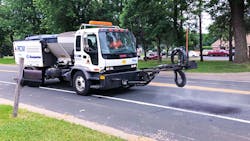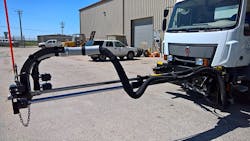Municipalities often find pothole repair to be both aggravating and expensive. One cause for these woes is the traditional repair technique known as “throw and go.” Although it may be quick, repairs completed with this technique have a short lifespan.
Crews are “truly having to go back and continually fix that same hole,” said Frank Connelly of RCM Specialties, a dealer of spray patching pavement repair equipment. Because those crews typically consist of three to five workers, these yearly repairs become costly from a labor perspective.
According to a 2016 study published by the Minnesota Department of Transportation, “The ideal repair would be a repair that lasts at least a year, can be performed in all seasons, and can be installed easily and relatively quickly—all while keeping traffic delays to a minimum.” Spray injection patching hits those qualifications, and, when utilizing a truck-mounted model, requires just one operator to complete pothole repairs.
As many municipalities face tight budgets, any expense requires careful consideration of return on investment. While cities will quickly realize savings by utilizing spray patching for pothole repair, the versatility of the technology also allows it to factor into long-term budgeting.
Spray patchers like the Roadpatcher from Schwarze are multipurpose machines—in addition to pothole repair, spray injection patching technology can be used to repair alligator cracking and cup cracking as well as perform other road maintenance functions. Hays County in Texas has found it to be especially helpful for chip sealing.
“We use the Roadpatcher to spray smaller roadway areas where it is not feasible to use the larger chip spreader crew,” said Aaron Jones, maintenance superintendent for the county. He describes the equipment as “vital” to the county’s day-to-day operations. “It gives us the ability to respond to requests for repairs quickly and efficiently,” Jones said, adding that the county also utilizes the Roadpatcher to repair potholes and shoulders and perform “any surface repair needed on the roadways.”
The fact that spray patch repairs can last up to five years allows them to get a handle on their road maintenance priorities. “From the savings standpoint alone of not having to go back out and do the repair again and again and again, that’s huge,” Connelly said. Those savings combine with the lower labor and materials costs, improved safety for operators and ability to complete repairs throughout the year to make spray patching a cost-efficient technology for municipalities in the short and long terms.
Editor's Note: Scranton Gillette Communications and the SGC Infrastructure Group are not liable for the accuracy, efficacy and validity of the claims made in this piece. The views expressed in this content do not reflect the position of the Roads & Bridges' Editorial Team.

